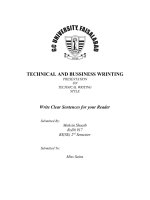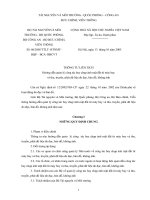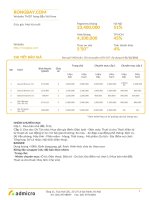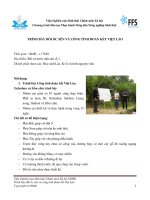Technical reference manual Bay control IED REC 670 Innovation from ABB .Technical reference manual Bay control IED REC 670 About this manual Document No: 1MRK 511 187-UEN Issued: March 2007 Product version: 1.1 Revision: – © Copyright 2007 ABB. All pptx
Bạn đang xem bản rút gọn của tài liệu. Xem và tải ngay bản đầy đủ của tài liệu tại đây (10.65 MB, 918 trang )
Technical reference manual
Bay control IED REC 670
Innovation
from
ABB
© Copyright 2007 ABB. All rights reserved.
Technical reference manual
Bay control IED
REC 670
About this manual
Document No: 1MRK 511 187-UEN
Issued: March 2007
Product version: 1.1
Revision: –
COPYRIGHT
WE RESERVE ALL RIGHTS TO THIS DOCUMENT, EVEN IN THE EVENT THAT A PATENT IS
ISSUED AND A DIFFERENT COMMERCIAL PROPRIETARY RIGHT IS REGISTERED. IMPROPER
USE, IN PARTICULAR REPRODUCTION AND DISSEMINATION TO THIRD PARTIES, IS NOT
PERMITTED.
THIS DOCUMENT HAS BEEN CAREFULLY CHECKED. HOWEVER, IN CASE ANY ERRORS ARE
DETECTED, THE READER IS KINDLY REQUESTED TO NOTIFY THE MANUFACTURER AT THE
ADDRESS BELOW.
THE DATA CONTAINED IN THIS MANUAL IS INTENDED SOLELY FOR THE CONCEPT OR
PRODUCT DESCRIPTION AND IS NOT TO BE DEEMED TO BE A STATEMENT OF GUARAN-
TEED PROPERTIES. IN THE INTERESTS OF OUR CUSTOMERS, WE CONSTANTLY SEEK TO
ENSURE THAT OUR PRODUCTS ARE DEVELOPED TO THE LATEST TECHNOLOGICAL STAN-
DARDS. AS A RESULT, IT IS POSSIBLE THAT THERE MAY BE SOME DIFFERENCES BETWEEN
THE HW/SW PRODUCT AND THIS INFORMATION PRODUCT.
Manufacturer:
ABB AB
Substation Automation Products
SE-721 59 Västerås
Sweden
Telephone: +46 (0) 21 34 20 00
Facsimile: +46 (0) 21 14 69 18
www.abb.com/substationautomation
Contents
PageChapter
Chapter 1 Introduction 1
Introduction to the technical reference manual 2
About the complete set of manuals for an IED 2
About the technical reference manual 3
Design of the Technical reference manual (TRM) 3
Introduction 4
Principle of operation 4
Input and output signals 7
Function block 7
Setting parameters 8
Technical data 8
Intended audience 8
General 8
Requirements 8
Related documents 9
Revision notes 9
Chapter 2 Local human-machine interface 11
Human machine interface 12
Small size graphic HMI 14
Introduction 14
Design 14
Medium size graphic HMI 16
Introduction 16
Design 16
Keypad 20
LED 22
Introduction 22
Status indication LEDs 22
Indication LEDs 22
LHMI related functions 24
Introduction 24
General setting parameters 24
Status indication LEDs 24
Design 24
Function block 25
Input and output signals 25
Indication LEDs 25
Introduction 25
Design 26
Function block 33
Input and output signals 33
Setting parameters 34
Contents
Chapter 3 Basic IED functions 37
Analog inputs 38
Introduction 38
Principle of operation 38
Function block 39
Output signals 41
Setting parameters 43
Authorization 49
Authorization handling in the tool 49
Authorization handling in the IED 55
Self supervision with internal event list 56
Introduction 56
Principle of operation 56
Internal signals 57
Run-time model 59
Function block 61
Output signals 61
Setting parameters 61
Technical data 61
Time synchronization 62
Introduction 62
Principle of operation 62
General concepts 62
Real Time Clock (RTC) operation 63
Synchronization alternatives 64
Function block 67
Output signals 67
Setting parameters 67
Technical data 70
Parameter setting groups 71
Introduction 71
Principle of operation 71
Function block 72
Input and output signals 73
Setting parameters 73
Test mode functionality 75
Introduction 75
Principle of operation 75
Function block 76
Input and output signals 77
Setting parameters 77
IED identifiers 78
Introduction 78
Setting parameters 78
Signal matrix for binary inputs (SMBI) 79
Introduction 79
Principle of operation 79
Function block 79
Input and output signals 79
Signal matrix for binary outputs (SMBO) 81
Introduction 81
Contents
Principle of operation 81
Function block 81
Input and output signals 81
Signal matrix for mA inputs (SMMI) 83
Introduction 83
Principle of operation 83
Function block 83
Input and output signals 83
Signal matrix for analog inputs (SMAI) 84
Introduction 84
Principle of operation 84
Function block 84
Input and output signals 85
Setting parameters 86
Summation block 3 phase (SUM3Ph) 88
Introduction 88
Principle of operation 88
Function block 88
Input and output signals 88
Setting parameters 89
Authority status (AUTS) 90
Introduction 90
Principle of operation 90
Function block 90
Output signals 90
Setting parameters 90
Goose binary receive 91
Function block 91
Input and output signals 92
Setting parameters 93
Chapter 4 Differential protection 95
High impedance differential protection (PDIF, 87) 96
Introduction 96
Principle of operation 96
Logic diagram 96
Function block 97
Input and output signals 97
Setting parameters 98
Technical data 98
Chapter 5 Current protection 99
Instantaneous phase overcurrent protection (PIOC, 50) 100
Introduction 100
Principle of operation 100
Function block 100
Input and output signals 101
Setting parameters 101
Contents
Technical data 102
Four step phase overcurrent protection (PTOC, 51_67) 103
Introduction 103
Principle of operation 103
Function block 107
Input and output signals 108
Setting parameters 109
Technical data 116
Instantaneous residual overcurrent protection (PIOC, 50N) 118
Introduction 118
Principle of operation 118
Function block 119
Input and output signals 119
Setting parameters 119
Technical data 120
Four step residual overcurrent protection (PTOC, 51N/67N) 121
Introduction 121
Principle of operation 121
Operating quantity within the function 122
Internal polarizing facility of the function 122
External polarizing facility for EF function 124
Base quantities within the function 124
Internal EF function structure 125
Four residual overcurrent stages 125
Directional supervision element with
integrated directional comparision stage 126
Second harmonic blocking element 128
Switch on to fault feature 130
Function block 135
Input and output signals 135
Setting parameters 136
Technical data 144
Sensitive directional residual overcurrent and
power protection (PSDE, 67N) 145
Introduction 145
Principle of operation 146
Introduction 146
Function block 153
Input and output signals 153
Setting parameters 156
Technical data 160
Thermal overload protection, one time constant (PTTR, 26) 162
Introduction 162
Principle of operation 162
Function block 166
Input and output signals 166
Setting parameters 167
Technical data 168
Thermal overload protection, two time constants (PTTR, 49) 169
Introduction 169
Principle of operation 169
Function block 173
Input and output signals 173
Contents
Setting parameters 174
Technical data 175
Breaker failure protection (RBRF, 50BF) 176
Introduction 176
Principle of operation 176
Function block 179
Input and output signals 180
Setting parameters 180
Technical data 181
Stub protection (PTOC, 50STB) 182
Introduction 182
Principle of operation 182
Function block 183
Input and output signals 183
Setting parameters 184
Technical data 184
Pole discordance protection (RPLD, 52PD) 185
Introduction 185
Principle of operation 185
Pole discordance signalling from circuit breaker 188
Unsymmetrical current detection 188
Function block 188
Input and output signals 189
Setting parameters 189
Technical data 190
Directional underpower protection (PDUP, 32) 191
Introduction 191
Principle of operation 192
Low pass filtering 194
Calibration of analog inputs 194
Function block 196
Input and output signals 196
Setting parameters 197
Technical data 198
Directional overpower protection (PDOP, 32) 199
Introduction 199
Principle of operation 200
Low pass filtering 202
Calibration of analog inputs 202
Function block 204
Input and output signals 204
Setting parameters 205
Technical data 206
Broken conductor check (PTOC, 46) 207
Introduction 207
Principle of operation 207
Function block 208
Input and output signals 208
Setting parameters 209
Technical data 209
Contents
Chapter 6 Voltage protection 211
Two step undervoltage protection (PTUV, 27) 212
Introduction 212
Principle of operation 212
Measurement principle 213
Time delay 213
Blocking 216
Design 218
Function block 220
Input and output signals 220
Setting parameters 221
Technical data 224
Two step overvoltage protection (PTOV, 59) 225
Introduction 225
Principle of operation 225
Measurement principle 226
Time delay 226
Blocking 228
Design 229
Function block 231
Input and output signals 231
Setting parameters 232
Technical data 235
Two step residual overvoltage protection (PTOV, 59N) 236
Introduction 236
Principle of operation 236
Measurement principle 236
Time delay 236
Blocking 240
Design 241
Function block 242
Input and output signals 242
Setting parameters 243
Technical data 245
Voltage differential protection (PTOV, 60) 246
Introduction 246
Principle of operation 246
Function block 248
Input and output signals 248
Setting parameters 249
Technical data 250
Loss of voltage check (PTUV, 27) 251
Introduction 251
Principle of operation 251
Function block 253
Input and output signals 253
Setting parameters 253
Chapter 7 Frequency protection 255
Contents
Underfrequency protection (PTUF, 81) 256
Introduction 256
Principle of operation 256
Measurement principle 256
Time delay 256
Voltage dependent time delay 257
Blocking 258
Design 258
Function block 259
Input and output signals 260
Setting parameters 260
Technical data 261
Overfrequency protection (PTOF, 81) 262
Introduction 262
Principle of operation 262
Measurement principle 262
Time delay 262
Blocking 263
Design 263
Function block 264
Input and output signals 264
Setting parameters 264
Technical data 265
Rate-of-change frequency protection (PFRC, 81) 266
Introduction 266
Principle of operation 266
Measurement principle 266
Time delay 267
Blocking 267
Design 267
Function block 268
Input and output signals 269
Setting parameters 269
Technical data 270
Chapter 8 Multipurpose protection 271
General current and voltage protection (GAPC) 272
Introduction 272
Inadvertent generator energization 272
Principle of operation 273
Measured quantities within the function 273
Base quantities for GF function 275
Built-in overcurrent protection steps 275
Built-in undercurrent protection steps 281
Built-in overvoltage protection steps 282
Built-in undervoltage protection steps 282
Inadvertent generator energization 282
Logic diagram 284
Function block 289
Input and output signals 290
Contents
Setting parameters 292
Technical data 301
Chapter 9 Secondary system supervision 305
Current circuit supervision (RDIF) 306
Introduction 306
Principle of operation 306
Function block 308
Input and output signals 308
Setting parameters 309
Technical data 309
Fuse failure supervision (RFUF) 310
Introduction 310
Principle of operation 310
Zero sequence 310
Negative sequence 314
du/dt and di/dt 314
Operation modes 315
Dead line detection 315
Function block 316
Input and output signals 316
Setting parameters 317
Technical data 318
Chapter 10 Control 319
Synchronizing, synchrocheck and energizing check (RSYN, 25) 320
Introduction 320
Principle of operation 320
Basic functionality 320
Logic diagrams 321
Function block 330
Input and output signals 331
Setting parameters 334
Technical data 336
Autorecloser (RREC, 79) 338
Introduction 338
Principle of operation 338
Logic Diagrams 338
Auto-reclosing operation Off and On 338
Auto-reclosing mode selection 338
Start auto-reclosing and conditions for
start of a reclosing cycle 339
Control of the auto-reclosing open time for shot 1 340
Long trip signal 341
Time sequence diagrams 347
Function block 351
Input and output signals 351
Setting parameters 353
Contents
Technical data 355
Apparatus control (APC) 357
Introduction 357
Principle of operation 357
Bay control (QCBAY) 358
Introduction 358
Principle of operation 358
Function block 359
Input and output signals 360
Setting parameters 360
Local/Remote switch (LocalRemote, LocRemControl) 360
Introduction 360
Principle of operation 360
Function block 362
Input and output signals 362
Setting parameters 363
Switch controller (SCSWI) 364
Introduction 364
Principle of operation 364
Function block 370
Input and output signals 370
Setting parameters 371
Circuit breaker (SXCBR) 372
Introduction 372
Principle of operation 372
Function block 376
Input and output signals 377
Setting parameters 378
Circuit switch (SXSWI) 378
Introduction 378
Principle of operation 378
Function block 383
Input and output signals 383
Setting parameters 384
Bay reserve (QCRSV) 384
Introduction 384
Principle of operation 384
Function block 387
Input and output signals 387
Setting parameters 388
Reservation input (RESIN) 388
Introduction 388
Principle of operation 389
Function block 390
Input and output signals 390
Setting parameters 391
Interlocking 392
Introduction 392
Principle of operation 392
Logical node for interlocking (SCILO) 395
Introduction 395
Principle of operation 395
Function block 396
Contents
Input and output signals 396
Interlocking for line bay (ABC_LINE) 397
Introduction 397
Function block 398
Logic diagram 399
Input and output signals 404
Interlocking for bus-coupler bay (ABC_BC) 406
Introduction 406
Function block 408
Logic diagram 409
Input and output signals 414
Interlocking for transformer bay (AB_TRAFO) 416
Introduction 416
Function block 417
Logic diagram 418
Input and output signals 421
Interlocking for bus-section breaker (A1A2_BS) 423
Introduction 423
Function block 424
Logic diagram 425
Input and output signals 426
Interlocking for bus-section disconnector (A1A2_DC) 428
Introduction 428
Function block 429
Logic diagram 430
Input and output signals 431
Interlocking for busbar earthing switch (BB_ES) 432
Introduction 432
Function block 432
Logic diagram 433
Input and output signals 433
Interlocking for double CB bay (DB) 433
Introduction 433
Function block 435
Logic diagrams 437
Input and output signals 443
Interlocking for 1 1/2 CB diameter (BH) 446
Introduction 446
Function blocks 448
Logic diagrams 451
Input and output signals 458
Horizontal communication via GOOSE for interlocking 463
Function block 463
Input and output signals 464
Setting parameters 465
Voltage control (VCTR) 466
Introduction 466
Principle of operation 467
Automatic tap changer control (ATCC) 467
Introduction 467
Principle of operation 467
Tap Changer (YLTC) 479
Introduction 479
Contents
Principle of operation 479
Connection between ATCC and YLTC 483
Function block 487
Input and output signals 491
Setting parameters 497
Technical data 502
Logic rotating switch for function selection
and LHMI presentation (SLGGIO) 504
Introduction 504
Principle of operation 504
Functionality and behaviour 505
Graphical display 506
Function block 508
Input and output signals 510
Setting parameters 511
Selector mini switch (VSGGIO) 512
Introduction 512
Principle of operation 512
Function block 513
Input and output signals 513
Setting parameters 514
Single point generic control 8 signals (SPC8GGIO) 515
Introduction 515
Principle of operation 515
Function block 515
Input and output signals 516
Chapter 11 Scheme communication 517
Scheme communication
logic for distance protection (PSCH, 85) 518
Introduction 518
Principle of operation 518
Blocking scheme 518
Permissive underreach scheme 519
Permissive overreach scheme 519
Unblocking scheme 519
Intertrip scheme 520
Simplified logic diagram 521
Function block 523
Input and output signals 523
Setting parameters 524
Technical data 524
Current reversal and weak-end infeed logic
for distance protection (PSCH, 85) 525
Introduction 525
Principle of operation 525
Current reversal logic 525
Weak end infeed logic 526
Function block 527
Input and output signals 528
Contents
Setting parameters 528
Technical data 529
Local acceleration logic (PLAL) 530
Introduction 530
Principle of operation 530
Zone extension 530
Loss-of-load acceleration 531
Function block 532
Input and output signals 532
Setting parameters 533
Scheme communication logic
for residual overcurrent protection (PSCH, 85) 534
Introduction 534
Principle of operation 534
Blocking scheme 535
Permissive under/overreach scheme 535
Unblocking scheme 536
Function block 538
Input and output signals 538
Setting parameters 539
Technical data 539
Current reversal and weak-end infeed logic
for residual overcurrent protection (PSCH, 85) 540
Introduction 540
Principle of operation 540
Directional comparison logic function 540
Fault current reversal logic 541
Weak and infeed logic 541
Function block 542
Input and output signals 543
Setting parameters 543
Technical data 544
Chapter 12 Logic 545
Tripping logic (PTRC, 94) 546
Introduction 546
Principle of operation 546
Logic diagram 547
Function block 552
Input and output signals 552
Setting parameters 553
Technical data 553
Trip matrix logic (GGIO) 554
Introduction 554
Principle of operation 554
Function block 556
Input and output signals 556
Setting parameters 558
Configurable logic blocks (LLD) 559
Introduction 559
Contents
Inverter function block (INV) 559
OR function block (OR) 559
AND function block (AND) 560
Timer function block (Timer) 561
Pulse timer function block (PULSE) 561
Exclusive OR function block (XOR) 562
Set-reset with memory function block (SRM) 562
Controllable gate function block (GT) 563
Settable timer function block (TS) 564
Technical data 565
Fixed signal function block (FIXD) 566
Introduction 566
Principle of operation 566
Function block 566
Input and output signals 567
Setting parameters 567
Boolean 16 to Integer conversion B16I 568
Introduction 568
Principle of operation 568
Function block 568
Input and output signals 569
Setting parameters 569
Boolean 16 to Integer conversion with logic node representation
(B16IGGIO) 570
Introduction 570
Principle of operation 570
Function block 570
Input and output signals 571
Setting parameters 571
Integer to Boolean 16 conversion (IB16) 572
Introduction 572
Principle of operation 572
Function block 572
Input and output signals 572
Setting parameters 573
Integer to Boolean 16 conversion with logic node representation
(IB16GGIO) 574
Introduction 574
Function block 574
Input and output signals 574
Setting parameters 575
Chapter 13 Monitoring 577
Measurements (MMXU) 578
Introduction 579
Principle of operation 580
Measurement supervision 580
Service values (MMXU, SVR) 585
Current Phasors (MMXU, CP) 590
Voltage phasors (MMXU, VN and VP) 591
Contents
Sequence quantities (MSQI, CSQ and VSQ) 591
Function block 591
Input and output signals 593
Setting parameters 596
Technical data 613
Event counter (GGIO) 614
Introduction 614
Principle of operation 614
Reporting 614
Design 614
Function block 615
Input signals 615
Setting parameters 615
Technical data 615
Event function (EV) 616
Introduction 616
Principle of operation 616
Function block 618
Input and output signals 618
Setting parameters 619
Fault locator (RFLO) 622
Introduction 622
Principle of operation 622
Measuring principle 623
Accurate algorithm for measurement of distance to fault 623
The non-compensated impedance model 627
IEC 60870-5-103 628
Function block 628
Input and output signals 628
Setting parameters 629
Technical data 630
Measured value expander block 631
Introduction 631
Principle of operation 631
Function block 632
Input and output signals 632
Disturbance report (RDRE) 633
Introduction 633
Principle of operation 633
Function block 641
Input and output signals 643
Setting parameters 645
Technical data 657
Event list (RDRE) 659
Introduction 659
Principle of operation 659
Function block 659
Input signals 659
Technical data 660
Indications (RDRE) 661
Introduction 661
Principle of operation 661
Function block 662
Contents
Input signals 662
Technical data 662
Event recorder (RDRE) 663
Introduction 663
Principle of operation 663
Function block 663
Input signals 663
Technical data 664
Trip value recorder (RDRE) 665
Introduction 665
Principle of operation 665
Function block 665
Input signals 666
Technical data 666
Disturbance recorder (RDRE) 667
Introduction 667
Principle of operation 667
Memory and storage 668
IEC 60870-5-103 669
Function block 669
Input and output signals 669
Setting parameters 670
Technical data 670
Chapter 14 Metering 671
Pulse counter logic (GGIO) 672
Introduction 672
Principle of operation 672
Function block 674
Input and output signals 674
Setting parameters 675
Technical data 675
Energy metering and demand handling (MMTR) 676
Introduction 676
Principle of operation 676
Function block 677
Input and output signals 677
Setting parameters 678
Chapter 15 Station communication 681
Overview 682
IEC 61850-8-1 communication protocol 683
Introduction 683
Generic single point function block (SPGGIO) 683
Introduction 683
Principle of operation 683
Function block 683
Input and output signals 684
Contents
Setting parameters 685
Generic double point function block (DPGGIO) 685
Introduction 685
Principle of operation 685
Function block 686
Input and output signals 686
Setting parameters 686
Generic measured values function block (MVGGIO) 686
Introduction 686
Principle of operation 686
Function block 686
Input and output signals 687
Setting parameters 687
Setting parameters 688
Technical data 688
LON communication protocol 689
Introduction 689
Principle of operation 689
Setting parameters 706
Technical data 706
SPA communication protocol 707
Introduction 707
Principle of operation 707
Communication ports 715
Design 716
Setting parameters 716
Technical data 717
IEC 60870-5-103 communication protocol 718
Introduction 718
Principle of operation 718
General 718
Communication ports 728
Function block 728
Input and output signals 731
Setting parameters 736
Technical data 739
Automation bits (AUBI) 740
Introduction 740
Principle of operation 740
Function block 741
Input and output signals 741
Setting parameters 743
Single command, 16 signals (CD) 755
Introduction 755
Principle of operation 755
Function block 755
Input and output signals 756
Setting parameters 756
Multiple command (CM) and Multiple transmit (MT) 757
Introduction 757
Principle of operation 757
Design 757
General 757
Contents
Function block 758
Input and output signals 758
Setting parameters 760
Chapter 16 Remote communication 761
Binary signal transfer to remote end 762
Introduction 762
Principle of operation 762
Function block 763
Input and output signals 765
Setting parameters 766
Chapter 17 Hardware 771
Overview 772
Variants of case- and HMI display size 772
Case from the rear side 775
Hardware modules 780
Overview 780
Combined backplane module (CBM) 781
Introduction 781
Functionality 781
Design 781
Universal backplane module (UBM) 783
Introduction 783
Functionality 783
Design 783
Power supply module (PSM) 786
Introduction 786
Design 786
Technical data 786
Numeric processing module (NUM) 787
Introduction 787
Functionality 787
Block diagram 788
Local human-machine interface (LHMI) 788
Transformer input module (TRM) 789
Introduction 789
Design 789
Technical data 789
Analog digital conversion module,
with time synchronization (ADM) 790
Introduction 790
Design 790
Binary input module (BIM) 792
Introduction 792
Design 792
Technical data 796
Binary output modules (BOM) 796
Contents
Introduction 796
Design 797
Technical data 799
Static binary output module (SOM) 799
Introduction 799
Design 799
Technical data 801
Binary input/output module (IOM) 802
Introduction 802
Design 802
Technical data 805
Line data communication module (LDCM) 807
Introduction 807
Design 807
Technical data 808
Serial SPA/IEC 60870-5-103 and LON
communication module (SLM) 809
Introduction 809
Design 809
Technical data 811
Galvanic RS485 communication module 812
Introduction 812
Design 812
Technical data 814
Optical ethernet module (OEM) 814
Introduction 814
Functionality 814
Design 814
Technical data 815
mA input module (MIM) 815
Introduction 815
Design 815
Technical data 817
GPS time synchronization module (GSM) 817
Introduction 817
Design 817
Technical data 820
GPS antenna 820
Introduction 820
Design 820
Technical data 822
IRIG-B time synchronization module IRIG-B 823
Introduction 823
Design 823
Technical data 824
Dimensions 825
Case without rear cover 825
Case with rear cover 826
Flush mounting dimensions 827
Side-by-side flush mounting dimensions 828
Wall mounting dimensions 830
External resistor unit for high impedance differential protection. 831
Mounting alternatives 832
Contents
Flush mounting 832
Overview 832
Mounting procedure for flush mounting 833
19” panel rack mounting 834
Overview 834
Mounting procedure for 19” panel rack mounting 835
Wall mounting 835
Overview 835
Mounting procedure for wall mounting 836
How to reach the rear side of the IED 836
Side-by-side 19” rack mounting 837
Overview 837
Mounting procedure for side-by-side rack mounting 838
IED 670 mounted with a RHGS6 case 838
Side-by-side flush mounting 839
Overview 839
Mounting procedure for side-by-side flush mounting 840
Technical data 841
Enclosure 841
Connection system 841
Influencing factors 842
Type tests according to standard 843
Chapter 18 Labels 845
Different labels 846
Chapter 19 Connection diagrams 849
Chapter 20 Time inverse characteristics 865
Application 866
Principle of operation 870
Mode of operation 870
Inverse characteristics 877
Chapter 21 Glossary 889
Glossary 890
Contents
1
About this chapter Chapter 1
Introduction
Chapter 1 Introduction
About this chapter
This chapter explains concepts and conventions used in this manual and provides information
necessary to understand the contents of the manual.
2
Introduction to the technical reference manual Chapter 1
Introduction
1 Introduction to the technical reference manual
1.1 About the complete set of manuals for an IED
The user’s manual (UM) is a complete set of five different manuals:
The Application Manual (AM) contains application descriptions, setting guidelines and setting
parameters sorted per function. The application manual should be used to find out when and for
what purpose a typical protection function could be used. The manual should also be used when
calculating settings.
The Technical Reference Manual (TRM) contains application and functionality descriptions
and it lists function blocks, logic diagrams, input and output signals, setting parameters and tech-
nical data sorted per function. The technical reference manual should be used as a technical ref-
erence during the engineering phase, installation and commissioning phase, and during normal
service.
The Installation and Commissioning Manual (ICM) contains instructions on how to install
and commission the protection IED. The manual can also be used as a reference during periodic
testing. The manual covers procedures for mechanical and electrical installation, energizing and
checking of external circuitry, setting and configuration as well as verifying settings and per-
forming directional tests. The chapters are organized in the chronological order (indicated by
chapter/section numbers) in which the protection IED should be installed and commissioned.
The Operator’s Manual (OM) contains instructions on how to operate the protection IED dur-
ing normal service once it has been commissioned. The operator’s manual can be used to find
out how to handle disturbances or how to view calculated and measured network data in order
to determine the cause of a fault.
The IED 670 Engineering guide (EG) contains instructions on how to engineer the IED 670
products. The manual guides to use the different tool components for IED 670 engineering. It
also guides how to handle the tool component available to read disturbance files from the IEDs
on the basis of the IEC 61850 definitions. The third part is an introduction about the diagnostic
tool components available for IED 670 products and the PCM 600 tool.
The IEC 61850 Station Engineering guide contains descriptions of IEC 61850 station engi-
neering and process signal routing. The manual presents the PCM 600 and CCT tool used for
station engineering. It describes the IEC 61850 attribute editor and how to set up projects and
communication.
en06000097.vsd
Application
manual
Technical
reference
manual
Installation and
commissioning
manual
Operator´s
manual
Engineering
guide









